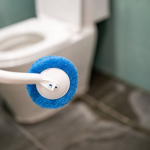Maintaining the cleanliness of your refrigerator is essential not only for aesthetics but also for the health and longevity of both the appliance and the food stored within. A tidy fridge can help prevent the growth of bacteria and unpleasant odors. The catch often is: how do you execute a deeper clean without turning your fridge off and disrupting its continuous cooling process? In this guide, you’ll learn the seamless method to spruce up your fridge interiors and exteriors effectively and efficiently, ensuring your food stays chilled and safe.
When prepping for a fridge clean-up, you will need cleaning solutions and tools that are suitable for food appliances. Those preparations include gathering non-toxic cleaning agents like a simple mix of vinegar and water or a mild soap solution. As you might have guessed, having dry cloths and sponges handy will also be crucial for the drying process after you clean each part of the fridge.
Preparation Steps Before Cleaning
The first step towards a clean fridge without power interruption is to ensure you have all the necessary cleaning supplies at arm’s reach. You will need gentle cleaning solutions that could also tackle tough stains. Baking soda is a great addition to your cleaning arsenal as it can help absorb odors, while a mix of warm water and dish soap can deal with sticky spillages. For a streak-free shine, white vinegar and water in equal parts could also work wonders. Then, arm yourself with a sponge or cloth for the application, and dry cloths for thoroughly wiping surfaces dry afterward.
To protect your food while cleaning, success lies in restraint: clean section by section so that the majority of your food can stay within the cooling confines of your fridge. Doing so will help keep your food at a safe temperature. Any items that you do need to remove temporarily can be placed into a cooler with ice packs to maintain a chill. This will also limit the time any perishable items are exposed to room temperature.
Creating a plan and a schedule for your fridge cleaning endeavor ensures efficiency. This might need some forethought—you wouldn’t want to conduct a deep clean right after a big grocery haul. Instead, consider timing your cleanup before a scheduled restock, when your fridge’s inventory is low.

Step-by-Step Cleaning Guide
When you’re ready to start, focus first on the removable components. This includes shelves, drawers, door bins, and egg holders, which often accumulate the most debris and spills. Here’s a methodical approach:
- Gently remove the shelves and drawers from the fridge. It is essential first to ensure these items have warmed up to room temperature to avoid cracking—especially if they are made of glass.
- Wash these components in the sink with your cleaning solution, scrubbing away any tough spots or stains. Then wipe them with a sponge and rinse. Stand them up vertically on a drying mat and allow them to air dry or wipe dry with a cloth to speed up the process.
For the interior surfaces, you’ll want to use a solution that does not leave behind any harmful residues. Spray the solution on the fridge’s interior walls and use a soft sponge or cloth to wipe it down. For stubborn spots, let the solution sit before wiping again. Always rinse the areas with water and then dry with a clean towel or cloth.
The rubber seal around your fridge door needs attention as well. Dirt and food residue can prevent the door from sealing properly, which could lead to energy loss and reduced efficiency. To clean, dampen a cloth with your vinegar and water solution, then wipe the seals thoroughly. Make sure they’re wiped dry to prevent mildew growth.
| Cleaning Supplies Checklist | Quantity |
|---|---|
| Mild soap or dishwashing liquid | As needed |
| Baking soda | 1 box |
| White vinegar | 1 bottle |
| Warm water | As needed |
| Sponge or soft cloths | 2-3 |
| Dry cloths for wiping | 2-3 |
| Cooler with ice (for food storage) | 1 (if needed) |
| Cleaning gloves | 1 pair |
Maintaining a clean rubber seal can also improve your refrigerator’s energy consumption. The fridge does not work as hard to maintain a constant temperature when the seal is free from obstructions and seals tightly.
The importance of also cleaning the fridge exterior should not be overlooked. Using a soft cloth, wipe down the outside surfaces. If you have a stainless steel refrigerator, you could also use a specialized cleaner to avoid streaking and maintain its shine. The handles are high-contact areas and should be sanitized regularly. Using a disinfectant or an alcohol solution will help ensure hygiene, which is especially important in preventing the spread of germs.
In the next section, we will delve into the best practices for organizing and restocking your refrigerator, as well as additional maintenance tips to help keep your appliance in top shape and prolong its lifespan.

Organizing and Restocking the Fridge
After thoroughly wiping and ensuring everything is wiped dry, it’s time to turn your attention to organizing and restocking your fridge. Doing so thoughtfully can help keep your refrigerator clean and allow for better air circulation, which helps food maintain its intended shelf life. The following are best practices for organizing items in your fridge:
- Keep similar items together, such as grouping all condiments in the door shelves and designating specific drawers for fruits and vegetables.
- Use clear storage containers to easily see items and prevent spills from leaking onto other food or shelves.
Smart restocking goes beyond mere organization and is about understanding how your fridge operates. For instance, the lower shelves are often cooler than the upper shelves due to the way air circulates. Therefore, placing items that require a more consistent and cooler temperature, such as milk and raw meats, on the lower shelves is advisable. Remember to leave space between items to promote air flow; an overcrowded fridge will have to work harder to cool, which can lead to increased energy costs and reduced efficiency.
Maintenance Tips and Keeping Your Fridge Clean
Regular maintenance and cleaning can help extend the life of your refrigerator and the freshness of your food. It’s recommended to perform a brief clean and check-up every month, with a more detailed clean every three to six months, depending on usage and necessity.
Regarding the interior, promptly wipe up spills to prevent them from sticking and staining the surfaces. Integrating this small habit can make your comprehensive cleanups much easier in the long run. Moreover, keeping an open box of baking soda in the fridge will absorb strong odors, keeping your fridge smelling fresh between more extensive cleanings.
Spill management is crucial, but so is preventive care. This includes vacuuming the coils and motor at the back or beneath the fridge, as dust buildup can impact the appliance’s performance. Ensuring your fridge is not too full or too empty is another simple yet effective trick. This prevents overburdening the appliance and allows for better air distribution.

Conclusion: Emphasizing the Benefits of a Clean Fridge
Ensuring your fridge remains clean can be a rewarding undertaking, reflecting positively on food safety and the lifespan of the appliance. Throughout this article, we have outlined the importance of cleaning without power interruption and provided a systematic guide on achieving a deeper clean. Using proper cleaning solutions, organizing, and restocking effectively will help improve the functionality of your fridge.
Regular maintenance and a spotless fridge can inspire confidence in your food storage and preparation practices. Above all, it’s a direct contribution to the health and well-being of you and your household. Let the satisfaction of a gleaming fridge motivate you to preserve its condition with routine care.
FAQs
- Do I need any special cleaning solutions for my fridge? You can use simple, non-toxic household items for cleaning your fridge. A mixture of baking soda and water for scrubbing and a combination of equal parts water and vinegar for wiping down surfaces and the rubber seal are both effective.
- How often should I organize and restock my fridge? Organizing should be an ongoing process, while restocking is typically based on your shopping habits. However, both should be approached with airflow and accessibility in mind to make the most of your refrigerator’s space and cooling capabilities.
- Is it necessary to clean the rubber seal around the door? Absolutely! The rubber seal keeps the cool air inside your fridge, ensuring it runs efficiently. Over time, it can accumulate crumbs and sticky residues, which can lead to a weak seal and potential energy loss.
- What items will I need to effectively clean my fridge? To effectively clean your fridge, you’ll need a few dry cloths, non-abrasive sponges, mild dish soap, baking soda, white vinegar, warm water, a cooler for temporary food storage, and cleaning gloves to protect your hands.
- Can cleaning my fridge without turning it off save on energy costs? Cleaning your fridge without turning it off not only saves on energy costs by maintaining its internal temperature but also reduces the risk of your food getting spoiled due to the temperature drop. It keeps your fridge running efficiently and prevents unnecessary energy expenditure during the rebooting process.


